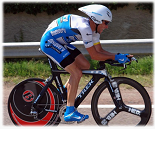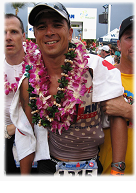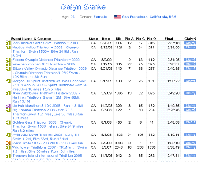This guest post is the first in what I hope will be a series of contributions by some of my former students from Brown University: people who took my course in Economic Sociology, and who have stayed in touch over the years. It’s always wonderful to hear from former students, and especially so when they find that material from my classes has been helpful in navigating their post-university lives. Since I was always rattling on in lectures about how pragmatic and useful Sociology can be–I was particularly fond of quoting Kurt Lewin, who is credited with saying “there is nothing so practical as a good theory”–it’s great to see how former students have applied sociological theories to make sense of their experiences.
In this entry, we find Galyn Burke–Brown class of ’05, formerly a competitive equestrienne, and now an enthusiastic triathlete–using Foucault and Putnam to shed light on the surging popularity of triathlon competition among American elites. Her analysis of what makes triathlons the “latest and greatest place to network professionally” follows.
*******************************************
Triathlon is the new Golf: As a young lawyer making a name for himself in the mid-seventies, my father’s superiors told him to “pick up golf” as a way to rise quickly within the firm, and to land lucrative clients. It’s still all about who you know, but if you want to get ahead in business today, don’t hit the putting green, sign up for an Ironman. Why?
Like Golf, Triathlon is cost prohibitive: The average annual income of an Ironman participant is nearly $160,000, while the average golfer makes a measly $100,980 a year, according to Golf.com’s 2009 Survey.
With Ironman entry fees upwards of $500 each (plus the flight and lodging expenses associated with destination racing), a decent bike starting around $3,000 (plus $400 for the shoes, helmet, pedals and accessories), $200 for swim, bike and run gear, and $300/month in coaching and facilities fees; you start to understand the need for that extra $60,000/year.

A $6,800 Trek TT Bike, with Carbon, disk
wheels, which cost upwards of $2,000/set.
Triathletes make better business connections: Like Golf, Triathlon entrances “Type A” personalities, obsessed with winning, even if victory requires continuous practice and focus. Unlike golf, Triathlon also demands incredible pain tolerance and phenomenal endurance. Consequently, “the sport attracts high-income, driven, focused individuals who are able and willing to pay the price in time and money,” says David Samson, Florida Marlins president, and Hawaii Ironman 2006 finisher.
Not only are triathletes more driven, they’re also younger. On average, Ironman triathletes are 35-44, while avid golfers are generally in their early 50’s. Consequently, triathletes are at the peak of their professional careers, while many golfers are contemplating retirement, and thereby less effective in helping you infiltrate the network or company of your choosing.
Triathlon is a better way to schmooze (on a Micro Level): Now that you’ve drawn all of the rich, hard working, high powered individuals into one sport, it is time to make connections. Typically, only four players participate in a round of golf, which takes around 4.5 hours. You likely know at least one or two of the other competitors if you’ve been invited to play in the first place, so you’re left with at best two networking opportunities, which isn’t an efficient way to find the right contact for you.
Most of the Multi-Sport fitness groups in my home town (Marin County, CA), host weekly group rides, averaging thirty to fifty participants. The group usually covers seventy miles in a given ride, thereby providing five hours (plus a group brunch) to make friends, and connections.

The PurplePatch Fitness Weekly
Saturday Group Ride, Marin County, CA
The group usually breaks into smaller packs of evenly matched athletes after a ten mile warm-up. As competitive, Type A folks, multiple members in a given group will eventually ask you how old you are, what team you belong to, and what you do (probably to ascertain how much time you have to train, how long you’ve been serious about the sport, who coaches you, and what if any advantage your bike may provide you).
It is during this hierarchical ranking process that you establish dominance over the somewhat older, not-as-fast man on the really expensive bike. He may be the CEO of a major tech company in Silicon Valley, but that is the professional “Pond” (Frank, 1987) or “Sphere” (Putnam, 1995). Right now, you’re both in the triathlon sphere, where you’re fitter, faster and had a better time at Ironman Canada last year. As Frank noted, it is relative status that creates happiness and satisfaction, and in this pond, your status is higher than his.
So, for the remainder of the ride (and during brunch afterward), he picks your brain about triathlon, and you arrange to have lunch with him at his office next week, a networking win you’d never enjoy if you’d attempted to engage said CEO in the professional Sphere.

Aaron Wallen: ‘World’s Fittest CEO, 2008’
Ironman Challenge, Kona, HI
Triathlon as a character reference: Not only have you now procured a meeting, you’ve already passed the first round of the interview process. The ability to withstand (and even enjoy) suffering is a form of ‘bonding social capital’ (Putnam, 2001) that forges a strong sense of collective identity. It implies a preference for achieving work-like goals in the leisure sphere, which translates seamlessly into a strong, professional recommendation from your new friend, the high powered CEO.
Triathlon is a better way to schmooze (on a Macro Level): There is no other sport in which every race includes Professional, Amateur and “Age Group” triathletes from under ten to over eighty, separated only by “wave” times, which are determined by age and gender. As Bob Babbitt, publisher of Competitor Magazine put it: “I can’t pitch to Barry Bonds or tee off with Tiger Woods, but I can be on the starting line with the top people in triathlon.” Consequently, you can train, compete and network with individuals of all ages and abilities, from around the world.
While the world of triathlon is growing rapidly (223,594 US adults participated in a triathlon in 2007, up from just 83,612 just ten years ago), Triathlon is still a small community, even at the Macro level. With a limited number of Ironman (2.4mi Swim, 112mi Bike, 26.2mi Run), Half Ironman (1.2mi Swim, 56mi Bike, 13.1mi Run), Olympic (.9mi Swim, 26mi Bike, 6.1mi Run) and Sprint (.5mi Swim, 16mi Bike, 2mi Run) distance races, you are assured to become familiar (and even friendly) with similarly matched athletes from across the country, and the world.
Triathlon is a reciprocal Panopticon: Your athletic club affiliations are declared on your uniform, and your age is written on your calf prior to each race (so you can check the legs of everyone you pass and everyone who passes you, to estimate ranking in on your age group during the actual race).
Your relative time and ranking is posted within minutes of completing the race, so all can see where you fall amongst the 2,000 or so athletes who participated that day. Award ceremonies are performed immediately, and results are posted online within 24 hours. You can even look up their participant’s photos!
Basically, Triathlon is a Panopticon (Bentham 1995 [1785]; Foucault 1995 [1977]), in which everyone is given the role of prison guard and prisoner. You can’t hide anything about yourself, but in turn, you know everything about everyone else.

Left: Athlink.com results display an athlete’s age, gender, city, and results for every event completed.

Right: Bentham’s Panopticon: A theoretical prison that allows guards to observe (-opticon) all (pan-) prisoners, who can’t reciprocally tell whether they are being watched.
Conclusion: Triathletes are a self selecting group of affluent, hig hly motivated individuals, who spend countless hours forging bonds through the competitive, grueling, and socially cohesive ritual of endurance athletics. The greater community convenes several times a year to establish relative rank by sex, age, casual, amateur and pro standards. With access to the region, age, gender and past performances of every athlete in this group, Triathletes are “tee’d up” to make local, national and international connections that turn into husbands, wives (38% of Triathletes are now women), employees, employers and friends. In a world where it’s all about whom you know, it doesn’t hurt to know the rich, successful, driven group that is Triathlon.
References
Bentham, Jeremy. 1995 [1785]. Panopticon Letters. Miran Bozovic (Ed.). London: Verso.
Foucault, Michel. 1995 [1977]. Discipline and Punish: The Birth of the Prison. New York: Vintage.
Frank, Robert. 1987. Choosing the Right Pond: Human Behavior and the Quest for Status. New York: Oxford University Press.
Putnam, Robert. 2001. Bowling Alone: The Collapse and Revival of American Community. New York: Simon and Schuster.
Comments 9
Tweets that mention Guest Post: The Economic Sociology of Triathlons » Economic Sociology -- Topsy.com — October 30, 2009
[...] This post was mentioned on Twitter by Andrew Louis and patrickjpr, Mike Stead. Mike Stead said: RT @patrickjpr: networking potential of triathlon http://is.gd/4HUNs < applies to Adventure Racing too. but less anal than Tri. IMHO. [...]
Guest Post: The Economic Sociology of Triathlons » Sociological Images — November 3, 2009
[...] formerly a competitive equestrienne, is now an enthusiastic triathlete. In the post below, originally at Economic Sociology, she uses Foucault and Putnam to shed light on the surging popularity of triathlon competition [...]
KMC — January 31, 2010
Brooke, what a fantastic article you wrote! I agree with all your points and I have to say, I know many golfers and only 2 Ironman triathletes and the triathletes are tremendously more successful than the golfers.
I would, however, argue that triathletes also make sure of the efficiency skills they learn in the races as well as their physical attractiveness gained from constant exercise to their advantage too.
Triathlons: the new golf? « Just Another OrgHead Outpost — January 31, 2010
[...] 31, 2010 by kelly317 “The Economic Sociology of Triathlons” argues that triathletes make excellent business and personal contacts by the inherent nature of [...]
ej13 — February 3, 2010
This post makes some excellent points that I never would have thought of. As a business major in college, I've always been told that I have to pick up golf if I'm going to make connections and "shmooze" my way into promotions and such. But triathlons do seem to house a wealthier, younger, and more driven crowd. I've always been a runner, so maybe it's time to pick up biking and swimming too.
carolyn kepcher — May 21, 2010
As a professional female, avid golfer and 41 years of age, I'm taken by this article. What I am taking from this post is that triathletes have exposure to the "elite" for networking. That may be true. In the seventies, perhaps that is how people perceived Golf. However, a lot has changed. We don't market to the elite! Golf is a game of honor, tradition, discipline and integrity and we encourage all walks of life to participate. Not ONE person is the face or voice of the game. The USGA encourages toddlers to teens through our "first tee" program and Internships. We encourage middle managers to retired CEOs. Golf IS good for business...but not just for the elite. So if our average income is only a measly $100K-ish, then we are doing a good job!
Mark — September 17, 2010
I was sent this article from a fellow triathlete that I hang with during the week at the strangest hours that you can imagine. I am a Sr. VP of a large company, and it is very true that this is an expensive sport. My nephew tried to get in, but as a 20 year old, he could not even afford the entry fees of a few local races at $100 a piece.
There is a broad spectrum of professional positions in our group that I know is similar in other groups. The opportunity to have a relationship between me, a 50 year old Sr. Executive, with my riding friends who are in their late 20's and early 30's is significant. We know each other well, and socially have a relationship. I just offered one lady a Director of Marketing job as we were riding last weekend. I know here family, I know her work ethic, and I have spent hours talking to her.
bill — October 24, 2010
I couldn't agree more. It is a wonderful sport. I am addicted, however one can compete in the sport using less expensive gear than is mentioned above. Lot's of 20 somethings ski for example which is quite an expensive sport but they take advantage of used equipment and packaged deals. One should never let cost sway a decision to do something. Bill